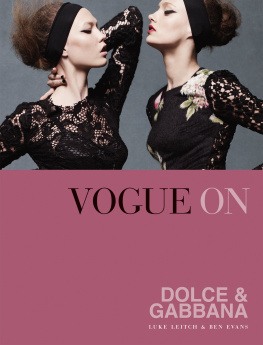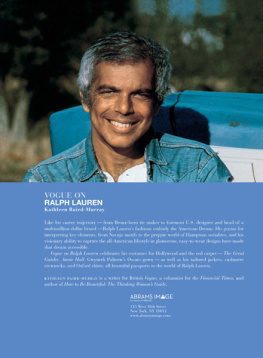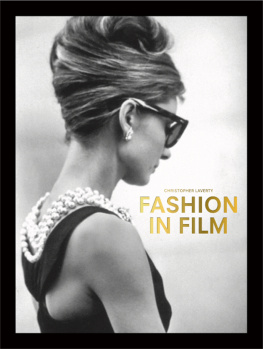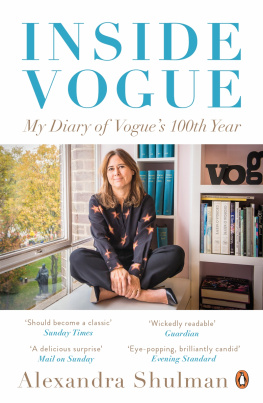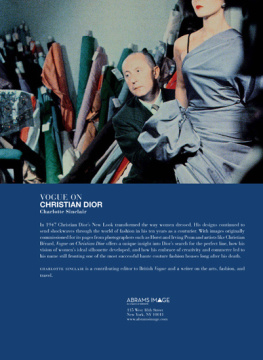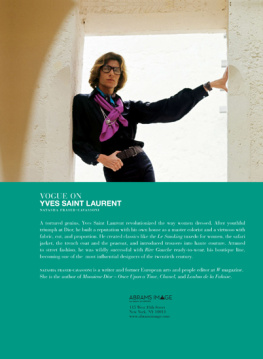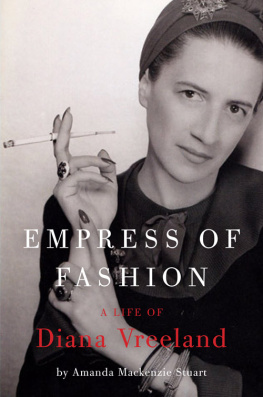Authors acknowledgments:
I am indebted to M. Hubert de Givenchy for his courteous replies to my questions. My special thanks are also due to Sarah Mitchell, my editor at Quadrille and to Brett Croft, Cond Nasts archive manager, for their patience and forbearance in the light of my demands. Beyond the names, I would like raise a cheer for the photographers and artists whose work has done so much to secure the memory of Hubert de Givenchys years in fashion.
A BRILLIANT HAND WITH SEPARATES.
VOGUE
BIRTH OF A
COUTURIER
A
W hen, as a young man, Hubert de Givenchy was invited to grand dances, he sat out because he didnt dance. He has said he spent the time looking. There was much to catch his eye. The newly optimistic mood in Paris that followed the Liberation in the late 1940s heralded a flurry of balls, tactfully held in aid of war charities. Vogue Paris published in color the Bal des Oiseaux at the Palais Rose in November 1948, the writer extolling the shimmering tones and glints of the tropical theme in a winter season. Pyramids of flowers and gilded branches decorated the ballroom, birds taken from their glass domes, perched like jewels on arboreal resting places. Among titled members of old French families could be seen Elsa Schiaparelli, her headdress and fingernails in Shocking Pink, the dancer and singer Josephine Baker wrapped in a feather boa, and the artist Christian Bb Brard. Prince Jean-Louis de Faucigny-Lucinge wrote of the period, Never, since the Age of Enlightenment has society found itself so close to artists. Guests proceeded up the great staircase of pink and gray marble to the reception rooms, admiring each others feathered masks, fans, and headdresses. Among the photographed guests was Hubert de Givenchy.
The young Frenchman, born 1927, was the scion of an aristocratic family of practicing Protestants in northern France. A distinguishing physical characteristic was his great height, standing at 78 inches. Handsome and said to be rather shy, he had a courteous demeanor. At the ball he can be seen as extending his apprenticeship in his chosen vocation, haute couture. His interest in womens fashion and fabrics had roots in childhood curiosity, and was to lead to a forty-year pursuit of what he deemed the most beautiful metier and his becoming one of the outstanding masters among a generation of couturiers that dominated fashion in Paris after the Second World War.
A long view of Givenchy in the pages of Vogue shows how much dress design owes him. His work carries on the historic traditions of haute couture as practiced by his mentor and idol, Cristbal Balenciaga, the Spanish master.

Hubert de Givenchy at the studio of his first salon, rue Alfred de Vigny, Paris, in the early Fifties. He is perfecting the shirring (gathers) on a work in progress, modeled in house.

Givenchys high-waist, minimum bodice (left) in white satin; a sash wraps the midriff underscoring a high ruffled dcolletage. A short evening dress (right) bells with a minute off-the-shoulder bodice. Illustration by Al Bouret, 1958.

British Vogue rated this dark fitted suit an absolute classic for its neat silhouette. Hat and gloves too are by Givenchy. Photograph by Alex Chatelain, 1989.
A
IN BREAKFAST AT TIFFANYS HUBERT DE GIVENCHYS ICONIC BLACK DRESS FOR AUDREY HEPBURN HAS ENTERED FASHION HISTORY.
VICTORIA & ALBERT MUSEUM HOLLYWOOD COSTUME, 2012

A poster of Audrey Hepburn in Givenchys emblematic black sheath for her character as Holly Golightly in Breakfast at Tiffanys, 1961. Directed by Blake Edwards, the movie is based on a story by Truman Capote. Audrey has said Clothes have given me the confidence I often needed.
To Susan Train, Vogues American editor in Paris, Givenchy came to personify not only the continuity of post-Second-World-War haute couture, but also links with the traditional prewar couture. He may not have moved the tectonic plates of fashion, but theres a strong case for recognizing his creative consistency in a period of almost wanton stylistic change. Always the perfectionist, his style is hard to define, as the classicism that was his bent breaks out from time to time into playfulness, fantasy, and surprise. Women have to thank him for the emphasis on comfort, a significant consideration since he worked at a time when Paris couture still cast a kindly eye on the corset and tight bodice. Fabrics he regarded with the scrutiny of an artist, seeing them as primary inspiration for forward thinking. Unusual materials inspired him, as did innovative combination of textures and types. He also helped develop the application of synthetics such as Lurex and Orlon. Above all, he intuited the female sartorial psyche. He really did know what women want. A Givenchy coat would be most womens ideal of the perfect way to look in daytime, commented British Vogue in 1960. It could have been said a thousand times in Vogues coverage of the designer, whatever the intended hour of the piece.
Also due to his hand are some supremely stylish moments in modern dress in movie production. Hubert de Givenchy and Audrey Hepburn met in connection with the costumes she was to wear in one of her Hollywood movies, an encounter that ricocheted across the boundaries of fashion and show business. In the process, Givenchys designs (but not Givenchy himself) won an Oscar and the leading lady became his muse, friend, and the personification of his style. To name but one of his sartorial hits in Hepburns movies, who can forget Holly Golightlys Little Black Dress in the opening shots of Breakfast at Tiffanys? Its a model of the form.
Sometimes a single millimeter is all it takes.
CATHERINE JOIN-DITERLE

French cut string bean, was how American Vogue viewed Givenchys black jersey dinner sheath. It possessed, no collar, no back, no nothing but terrific shape. Photograph by John Rawlings, 1953.
G ivenchy has said that to dress a woman is to enhance her beauty, and I questioned him on the matter in an interview. Trying to make a woman more beautiful is to try to understand her well, for her to be well dressed and above all, comfortable in her clothes. If a woman moves well, her gestures will be natural and she will be happy, he commented. Clothes can change many things in the life of a woman. Many of my clients have told me that when they met the man of their life, they wore a little plain Givenchy dress and it helped them conquer their future husband. Perhaps this is a compliment that these clients and friends wanted to pay me, but I also know that there is some real evidence for this testimony.
It has also has to be said that a little plain Givenchy dress conceals the intense craftsmanship that goes into its magic. Here is an account of a model that the imagined client or friend might have been wearing. British Vogue and Vogue Paris in September 1955 gave a full page to a shot by Henry Clarke of the couturiers Long, Lean Dress. It was captioned, Superbly detailed arrow-slim interpretation of the pared down minimum, collarless, short sleeved, his oatmeal tweed dress has a semi-fitted diagonally seamed waistline, is high-necked, flat in front. What may also have had a bearing on the case of the aforesaid smitten spectator is the creators observation that In haute couture we are cosmetic surgeons, erasing imperfections and refining the silhouette.
Next page

